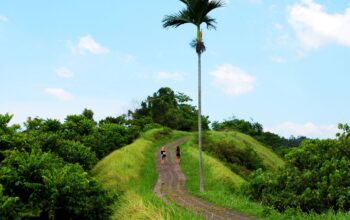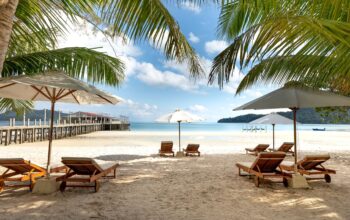General Location Questions
Where exactly is Bali located?
Bali is situated right in the middle of the Indonesian archipelago, positioned between Java Island to the west and Lombok Island to the east. If you fly from Jakarta, the journey takes less than two hours, only about one and a half hours. Its strategic location makes Bali very easily accessible from various major cities in Indonesia and internationally.
What are the main regions in Bali?
Generally, Bali is divided into several main regions such as South Bali, North Bali, West Bali, East Bali, and Central Bali. Each of these regions has its own unique characteristics. For example, some areas are famous for beach tourism, some for cultural tourism, and some are popular for nature tourism.
What differentiates North Bali, South Bali, East Bali, and West Bali?
Every region in Bali has a different character:
South Bali is synonymous with popular tourist spots like Kuta, Seminyak, and Jimbaran. The atmosphere here is lively, full of tourists, and the beaches are incredibly beautiful with white sand.
North Bali is much calmer and more relaxed, perfect for those who want to avoid the crowds. Lovina is the main attraction here, known for its calm beaches and dolphins.
West Bali is very suitable for those who love wild nature adventures, as it is home to West Bali National Park, which offers the beauty of forests, rare animals, and fantastic snorkeling spots.
East Bali is more traditional with an authentic village atmosphere. In this area, you can enjoy famous diving spots like Amed and Tulamben, as well as well-preserved Balinese culture.
Questions about Topography and Natural Conditions
What is the general geographical condition of Bali?
Bali’s geography is truly complete and diverse. You can find extensive white sand beaches in the south, cool high mountains in the center, and picturesque terraced green rice fields that are very Instagrammable. This geographical diversity makes Bali an ideal holiday destination for various types of travelers, from those who love nature and adventure to those who simply want to relax.
Does Bali have mountains or active volcanoes?
Bali has several active volcanoes, the most well-known being Mount Agung and Mount Batur. Mount Agung has erupted several times, so tourists always need to check the latest information if they plan to hike or travel around it. Meanwhile, Mount Batur is often visited for trekking and enjoying spectacular sunrises.
What are the beaches like in Bali geographically?
Beaches in Bali vary depending on the region. South Bali beaches are famous for their soft white sand, perfect for swimming, sunbathing, and surfing. Meanwhile, beaches in North and East Bali usually have black sand due to volcanic activity. Despite the differences, these beaches all offer amazing views and atmospheres.
Are there any highland areas in Bali?
Yes, Bali has cool highland areas like Kintamani, Bedugul, and Munduk. These areas are often visited by tourists to enjoy mountain views, strawberry, coffee, and vegetable plantations, as well as beautiful lakes. The cool atmosphere makes you forget you’re on a tropical island.
Questions about Climate and Weather
What are the weather and climate conditions in Bali throughout the year?
Generally, Bali has two main seasons: the dry season which lasts from around April to October, and the rainy season from November to March. The dry season is usually hot, sunny, and slightly drier. The rainy season is still warm, but rain falls more frequently, sometimes heavily but not for long.
When is the best time to visit Bali according to its geographical and weather conditions?
The best time to visit Bali is usually between April and September because the weather is the brightest and driest, perfect for various outdoor activities like surfing, snorkeling, or simply enjoying the beach. However, if you prefer a quieter and less crowded atmosphere, the rainy season can also be an interesting alternative.
Is there a difference in weather in various regions of Bali?
Yes, there is. For example, highland areas like Bedugul and Kintamani are colder and cooler, and can even be quite chilly at night. Conversely, coastal areas like Kuta, Jimbaran, or Seminyak are usually hot all day. So, you need to adjust the clothes you bring to your travel destination.
Questions about Natural Disasters and Mitigation
What geographical risks should be aware of when vacationing in Bali?
The main risks you need to be aware of are earthquakes and volcanic activity from Mount Agung or Mount Batur. Although not always occurring, it’s important to stay updated with information from local authorities, especially when there’s a significant increase in volcanic activity.
Is Bali prone to earthquakes or tsunamis?
Geographically, Bali is an earthquake-prone area due to its position at the meeting point of tectonic plates. However, tsunamis are very rare. Nevertheless, it is still important to know evacuation points or safe areas around your accommodation.
Does volcanic activity affect tourists in Bali?
Yes, especially activity from Mount Agung. When this mountain is active, there is usually a ban on approaching a certain radius for the safety of tourists. However, this activity rarely causes widespread disruption, so most areas in Bali remain safe to visit.
Questions about Geographically Related Infrastructure
How is the condition of roads or access to certain areas in Bali?
Generally, roads leading to famous tourist locations in Bali are relatively good and smooth. However, there are some areas with more difficult access such as Nusa Penida or more remote mountainous regions. Sometimes you need to be extra careful, especially during the rainy season, as roads can be slippery or damaged.
Are there certain geographical conditions in Bali that make travel more difficult?
Yes, roads in mountainous areas like Munduk or Bedugul are usually winding and steep. During the rainy season, roads can also be covered in fog or be slippery. In addition, some access to certain beaches or tourist spots like Nusa Penida might be a bit difficult because the roads are not yet very good.
Conclusion
Understanding Bali’s geographical conditions before your vacation can make your trip much more comfortable and enjoyable. You can plan your vacation better, know the right places according to your wishes, and of course, be more aware of potential risks. So, your vacation to Bali will be even more fun and hassle-free!










